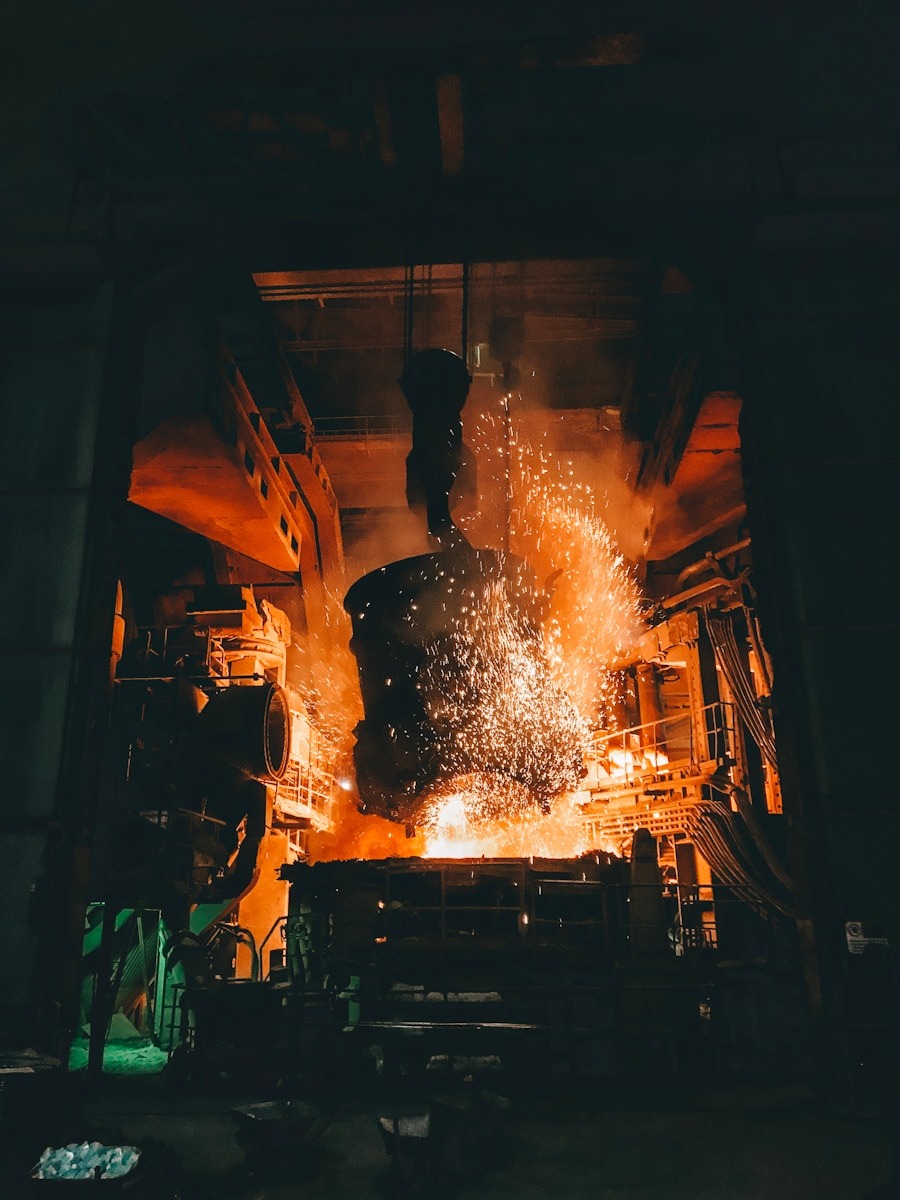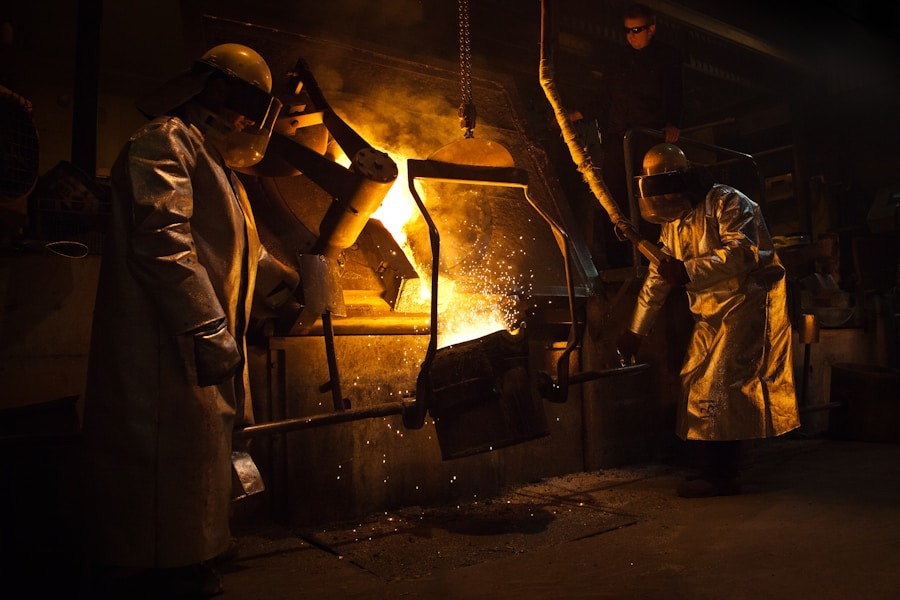Metallurgy, the science and technology of metals, encompasses a wide range of processes that involve the extraction, refinement, and manipulation of metallic elements. This discipline is not merely confined to the study of metals themselves; it also includes the understanding of their physical and chemical properties, as well as their interactions with other materials. The significance of metallurgy extends beyond the realm of engineering and manufacturing; it plays a crucial role in various sectors, including aerospace, automotive, construction, and electronics.
The evolution of metallurgy has been pivotal in shaping human civilization, influencing everything from the tools we use to the infrastructure we build. The journey of metallurgy began thousands of years ago, with early humans discovering that certain ores could be transformed into usable metals through heating and hammering. This primitive understanding laid the groundwork for more sophisticated techniques that would emerge over time.
Today, metallurgy is a highly specialized field that integrates principles from physics, chemistry, and engineering. It involves not only the production of metals but also the development of alloys and composite materials that enhance performance and durability. As industries continue to evolve, the role of metallurgy becomes increasingly vital in addressing challenges such as resource scarcity, environmental impact, and technological advancement.
Key Takeaways
- Metallurgy is the study of metals and their properties, including extraction, processing, and production.
- Ancient metallurgy techniques date back to the Bronze Age and include methods such as smelting and forging.
- Modern metallurgy innovations include advanced materials, nanotechnology, and additive manufacturing.
- Metallurgy has a significant impact on industry, including construction, automotive, aerospace, and electronics.
- Sustainable metallurgy practices focus on reducing environmental impact, recycling, and using renewable energy sources.
- Future trends in metallurgy include the development of new alloys, advanced manufacturing techniques, and the integration of digital technologies.
Ancient Metallurgy Techniques
The origins of metallurgy can be traced back to ancient civilizations, where early humans first experimented with native metals like gold, copper, and silver. These metals were often found in their pure forms and required minimal processing. The earliest known evidence of metalworking dates back to around 6000 BCE in the region of Anatolia (modern-day Turkey), where copper was used to create simple tools and ornaments.
The techniques employed during this period were rudimentary; artisans would heat copper ores in fires and then hammer them into shape. This process, known as cold working, allowed for the creation of basic implements that were stronger than their stone counterparts. As societies advanced, so did their metallurgical techniques.
The discovery of smelting around 4000 BCE marked a significant turning point in metallurgy. Smelting involves heating ores to high temperatures to extract metals from their oxides or sulfides. The Sumerians and Egyptians were among the first to develop this technique, using it to produce bronze by alloying copper with tin.
This innovation led to the Bronze Age, a period characterized by the widespread use of bronze tools and weapons. The ability to create stronger and more durable materials revolutionized warfare, agriculture, and craftsmanship. Ancient metallurgists also experimented with various methods of casting, such as sand casting and lost-wax casting, which allowed for more intricate designs and shapes.
Modern Metallurgy Innovations

In contemporary times, metallurgy has undergone a remarkable transformation driven by advancements in technology and scientific understanding. One of the most significant innovations is the development of advanced materials such as high-performance alloys and composites. These materials are engineered to exhibit specific properties tailored for particular applications.
For instance, titanium alloys are now widely used in aerospace due to their exceptional strength-to-weight ratio and corrosion resistance. Similarly, superalloys, which are designed to withstand extreme temperatures and stresses, are critical in jet engine manufacturing. Another groundbreaking advancement in modern metallurgy is the advent of additive manufacturing, commonly known as 3D printing.
This technology allows for the layer-by-layer construction of metal parts directly from digital models. Additive manufacturing has revolutionized traditional manufacturing processes by enabling complex geometries that were previously impossible to achieve with conventional methods. Industries such as aerospace and medical devices have embraced this technology for its ability to reduce material waste and lead times while enhancing design flexibility.
Furthermore, innovations in surface engineering techniques, such as coatings and treatments, have improved the performance and longevity of metal components across various applications.
Impact of Metallurgy on Industry
The impact of metallurgy on industry cannot be overstated; it serves as the backbone for numerous sectors that drive economic growth and technological progress. In construction, for example, steel—a product of metallurgical processes—has become a fundamental material for building infrastructure such as bridges, skyscrapers, and highways. The strength and versatility of steel allow architects and engineers to design structures that are not only functional but also aesthetically pleasing.
The development of high-strength low-alloy (HSLA) steels has further enhanced the performance characteristics of construction materials, enabling lighter structures without compromising safety. In the automotive industry, metallurgy plays a crucial role in vehicle design and manufacturing. The shift towards lightweight materials is driven by the need for fuel efficiency and reduced emissions.
Advanced high-strength steels (AHSS) are increasingly used in vehicle bodies to achieve this goal while maintaining safety standards. Additionally, the use of aluminum alloys has gained traction due to their lightweight properties and resistance to corrosion. The integration of metallurgical innovations has led to the production of vehicles that are not only more efficient but also safer for occupants and pedestrians alike.
Sustainable Metallurgy Practices
As global awareness of environmental issues grows, sustainable practices in metallurgy have become a focal point for researchers and industry leaders alike. Traditional metallurgical processes often involve significant energy consumption and generate substantial waste products. However, advancements in recycling technologies have paved the way for more sustainable practices within the industry.
For instance, secondary aluminum production—recycling aluminum scrap—requires only about 5% of the energy needed for primary aluminum production from bauxite ore.
Moreover, the concept of circular economy is gaining traction within metallurgy.
This approach emphasizes the importance of reusing materials and minimizing waste throughout the lifecycle of products. Companies are increasingly adopting practices such as remanufacturing and refurbishing metal components to extend their lifespan rather than discarding them after use. Additionally, research into bio-based materials and green chemistry is exploring alternative methods for metal extraction that minimize environmental impact.
These sustainable practices not only benefit the planet but also enhance the economic viability of metallurgical operations by reducing costs associated with raw material procurement and waste management.
Future Trends in Metallurgy

Looking ahead, several trends are poised to shape the future landscape of metallurgy. One significant trend is the increasing integration of artificial intelligence (AI) and machine learning into metallurgical processes. These technologies can optimize production parameters, predict material behavior under various conditions, and enhance quality control measures.
By leveraging data analytics, metallurgists can make informed decisions that improve efficiency and reduce waste throughout the manufacturing process. Another emerging trend is the exploration of new materials beyond traditional metals. Researchers are investigating metal-matrix composites (MMCs) that combine metals with ceramics or polymers to achieve superior properties such as enhanced strength or thermal resistance.
Additionally, advancements in nanotechnology are leading to the development of nanostructured materials that exhibit unique characteristics at the atomic level. These innovations hold promise for applications in fields ranging from electronics to biomedical devices. Furthermore, as industries strive for greater sustainability, there will be an increased focus on developing eco-friendly metallurgical processes that minimize environmental impact while maximizing resource efficiency.
This includes innovations in hydrometallurgy—using aqueous solutions for metal extraction—and biometallurgy—leveraging biological organisms for metal recovery. As these trends continue to evolve, metallurgy will remain at the forefront of technological advancement, driving progress across multiple sectors while addressing pressing global challenges related to sustainability and resource management.
In a related article discussing sociological concepts such as status, role, groups, culture, socialization, structure, function, social control, and change, the importance of understanding the dynamics of human interaction and societal norms is highlighted. This article delves into how these concepts shape our behaviors and relationships within various social contexts. To learn more about this fascinating topic, check out com/sociological-concepts-understanding-status-role-groups-culture-socialization-structure-function-social-control-and-change/’>this insightful article.
FAQs
What is metallurgy?
Metallurgy is the science and technology of extracting metals from their ores, refining them, and preparing them for use in various applications.
What are some recent developments in metallurgy?
Recent developments in metallurgy include the use of advanced materials such as high-strength alloys, composites, and nanomaterials, as well as advancements in metal 3D printing and additive manufacturing techniques.
How has metallurgy contributed to technological progress?
Metallurgy has played a crucial role in technological progress by providing the materials and tools necessary for various industries, including aerospace, automotive, construction, and electronics.
What are some key challenges in the field of metallurgy?
Some key challenges in metallurgy include the need for sustainable and environmentally friendly production processes, as well as the development of new materials with enhanced properties and performance.
What are some potential future developments in metallurgy?
Potential future developments in metallurgy include the use of advanced computational modeling and simulation techniques, the exploration of new materials and alloys, and the integration of metallurgy with other fields such as nanotechnology and biotechnology.






















+ There are no comments
Add yours